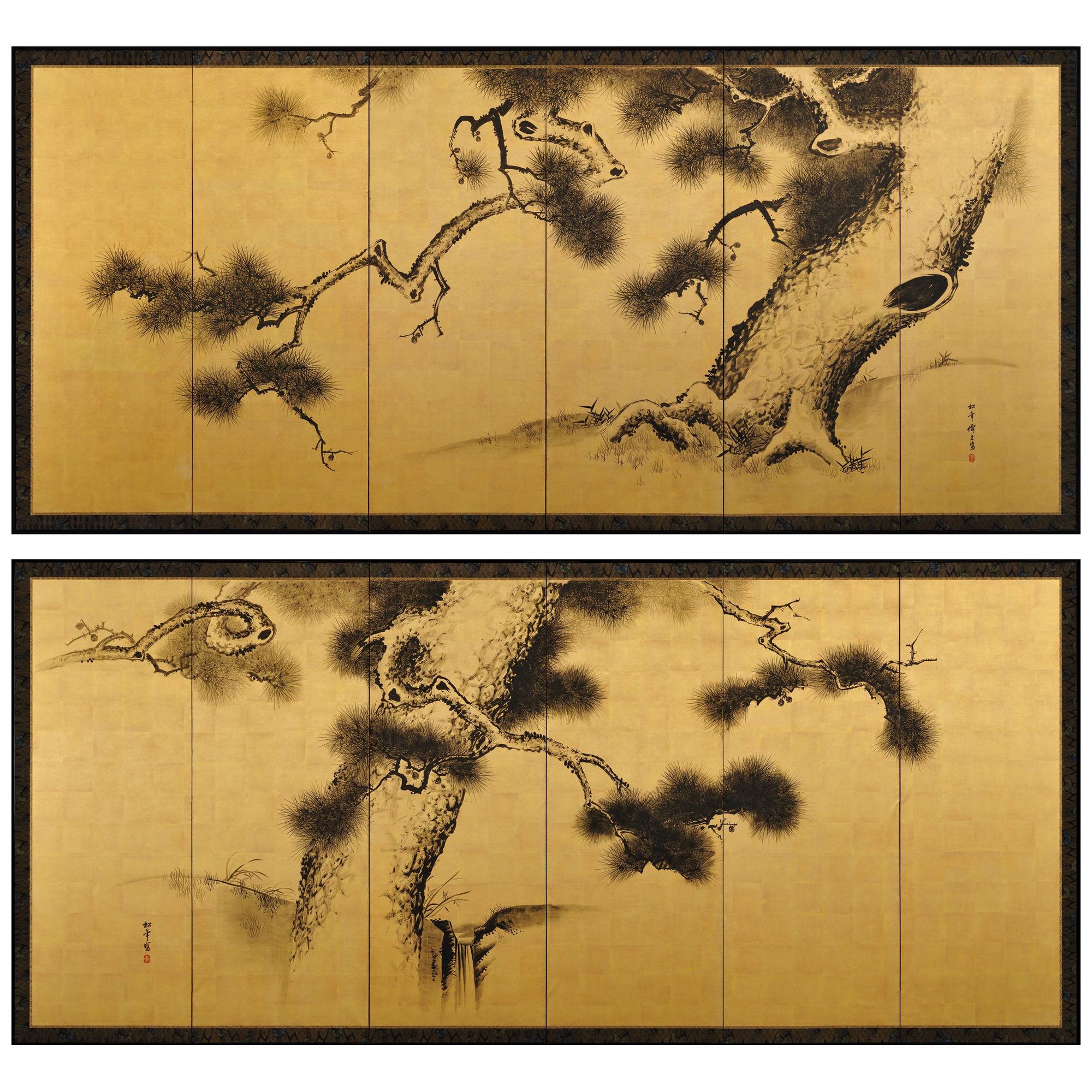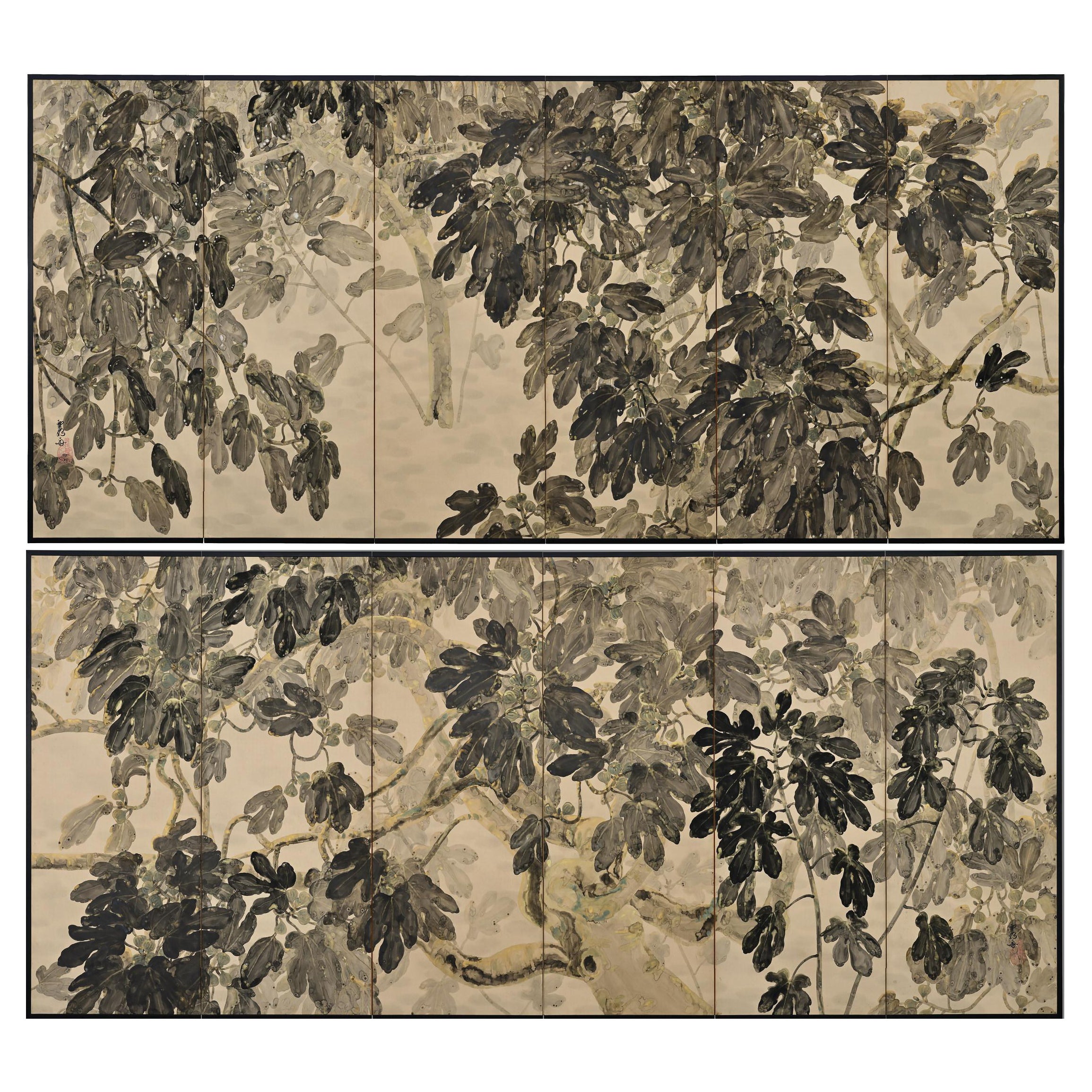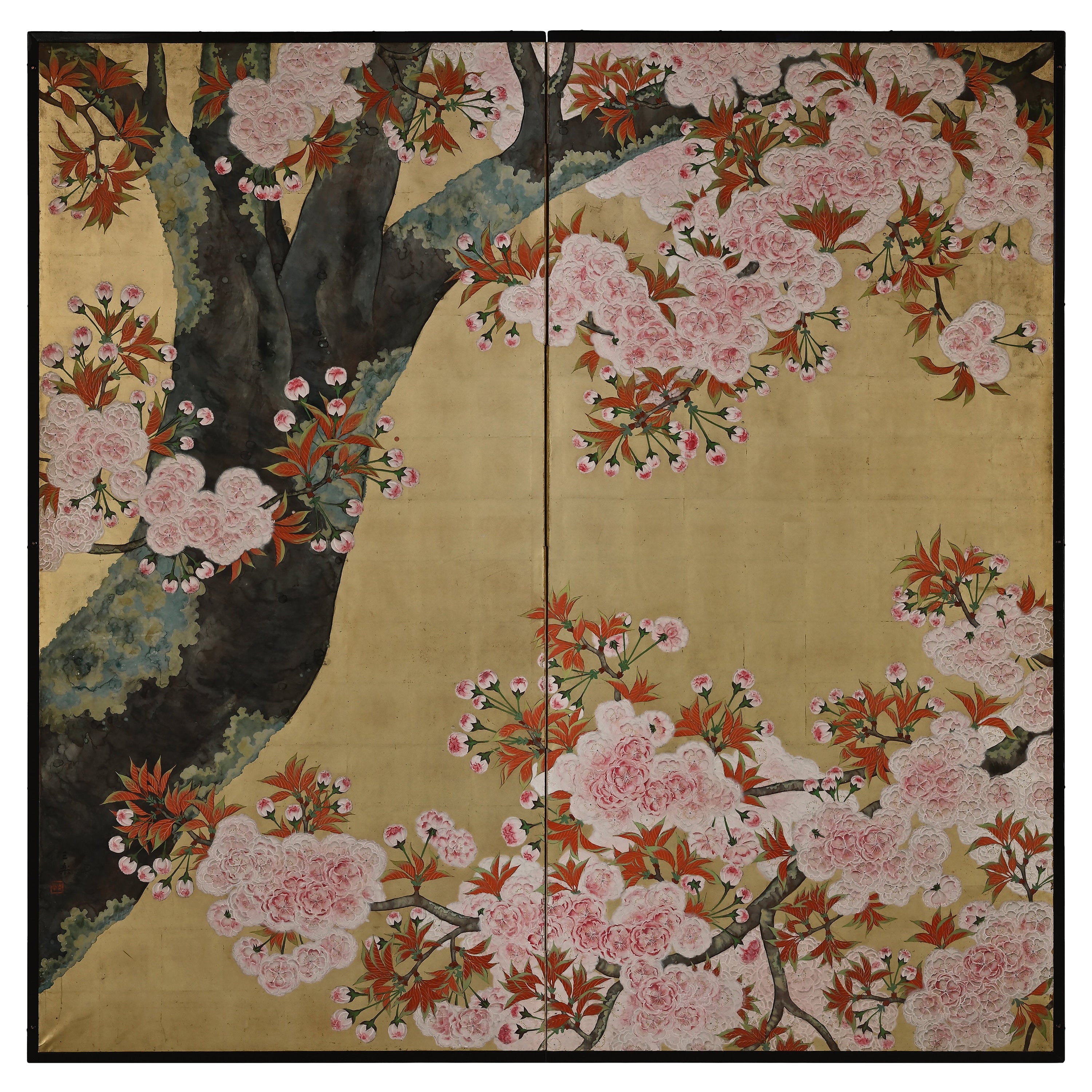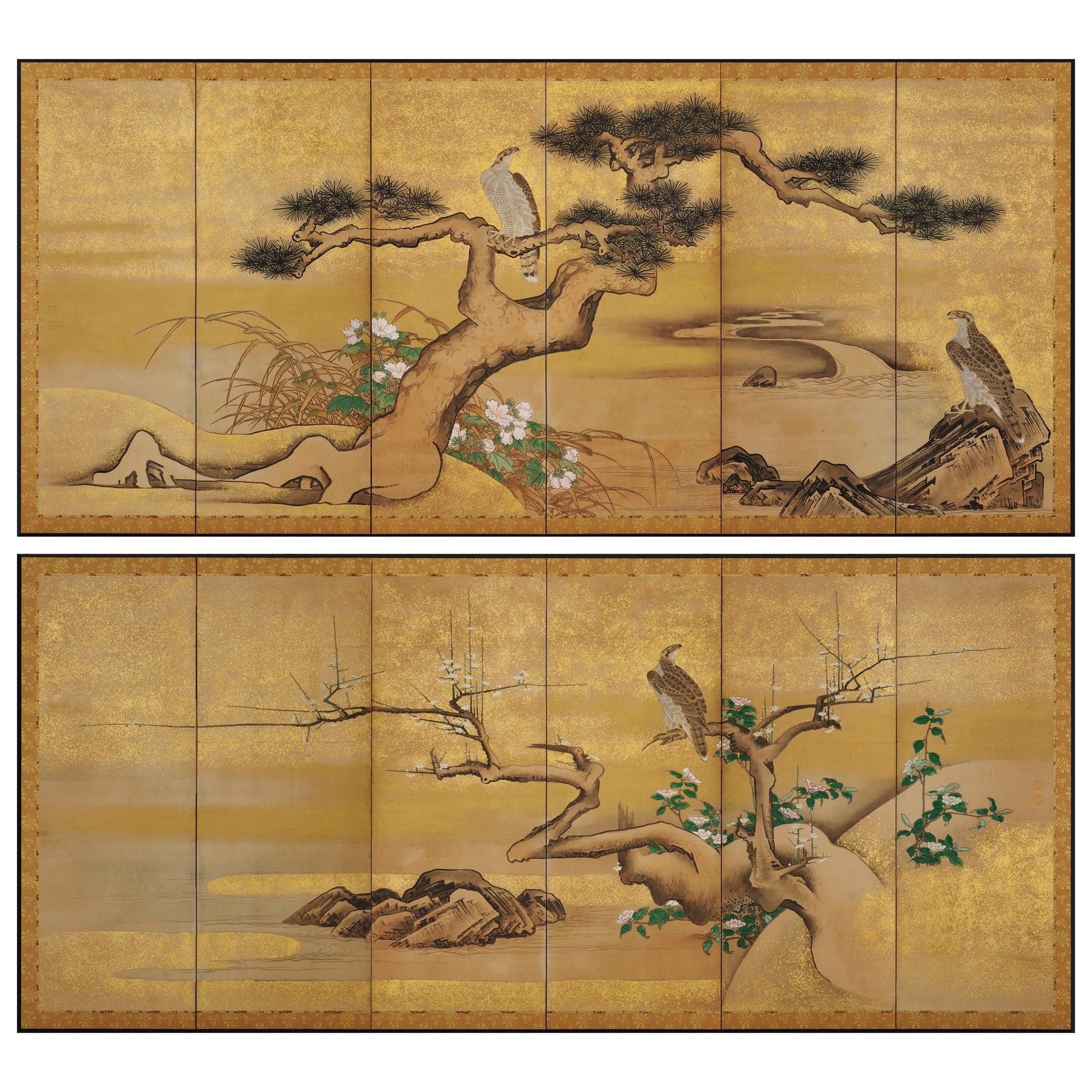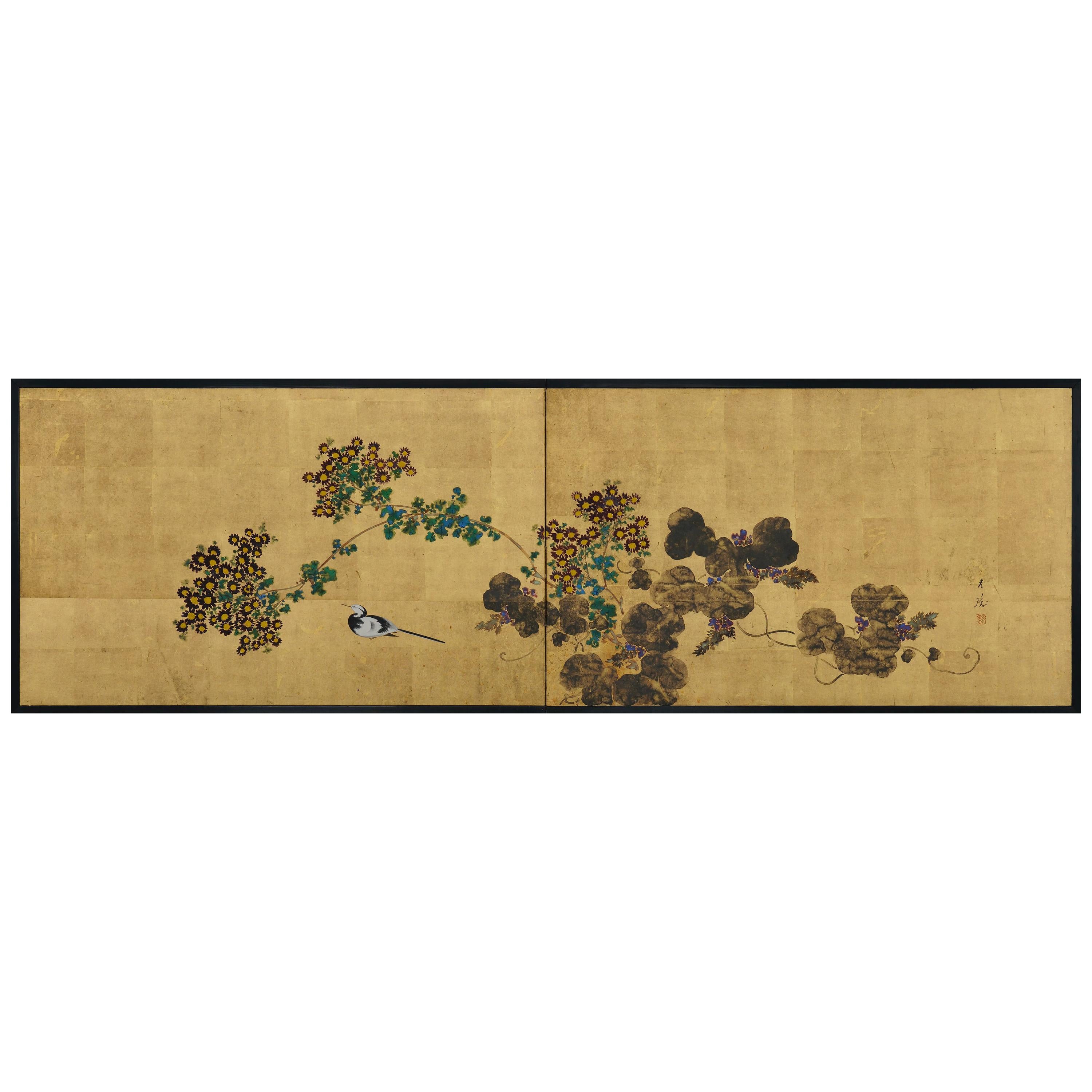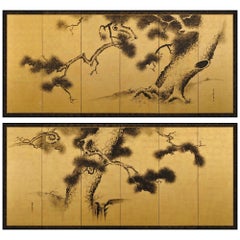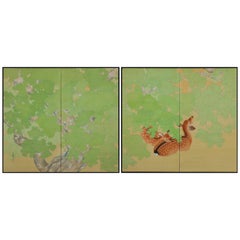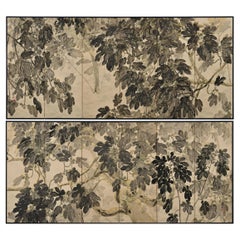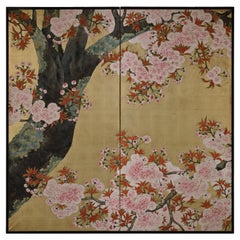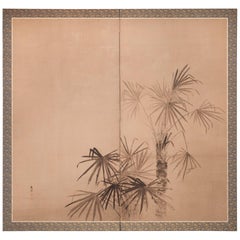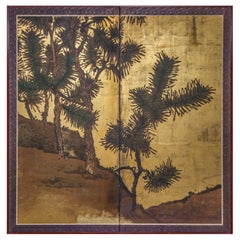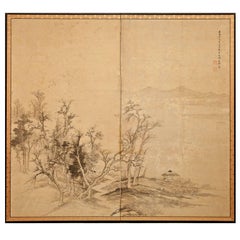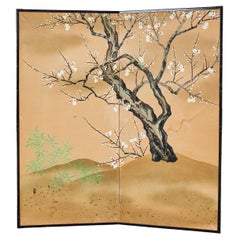Items Similar to Early 20th Century Japanese Screen Pair - Ink Pine Trees on Gold
Want more images or videos?
Request additional images or videos from the seller
1 of 8
Early 20th Century Japanese Screen Pair - Ink Pine Trees on Gold
About the Item
Imao Keisho (1902-1993)
Pine Trees
Early 20th Century, Circa 1930
Pair of six-panel Japanese screens. Ink on silk and gold leaf.
Dimensions: Each screen H. 67.5” x 148” (172 cm x 376 cm)
A pair of monumental six-panel Japanese pine screens by the renowned Nihonga artist Imao Keisho. Here Keisho entirely removed the background and brought the pine trees to the surface of the painting. This simplification of the elements makes the scene exceptionally direct and compelling and injects a very modern feel into the screens, which are extraordinary for their technical virtuosity. The work is both majestic and delicate, with Keisho’s exquisite brushwork defining the complex and visually stunning scene. The bright gold of the screens and the rich black of the ink demonstrate a magnificent visual power. Keisho’s complete and meticulous control of the ink is made possible by the design of the folding screens themselves. The fronts are first laid with silk before gold leaf is layered on top, allowing artists a highly refined silk canvas with all the visual benefits of the gold leaf.
Imao Keisho (1902-1993) is the adopted son of and successor to Imao Keinen (1845-1924). A highly talented Nihonga artist, Keisho fully inherited Imao Keinen’s painting style, and his brush skills are widely recognized. Like his father Keinen, Keisho did not affiliate himself with any painting association and their exhibitions, instead focusing on a series of one-man shows. His large-scale works were exhibited at various temples and shrines in Kyoto, including Kinkaku-ji, Ginkaku-ji, and Honen-in. He was favored with many private commissions, including fusuma sliding door panels in major Kyoto temples. His most famous work being his tiger paintings on the sliding doors of Konkai Komyo-ji temple in Kyoto. Keisho also presented his works to the Imperial family on several occasions.
- Dimensions:Height: 67.5 in (171.45 cm)Width: 148 in (375.92 cm)Depth: 0.75 in (1.91 cm)
- Style:Showa (Of the Period)
- Materials and Techniques:
- Place of Origin:
- Period:
- Date of Manufacture:circa 1930
- Condition:
- Seller Location:Kyoto, JP
- Reference Number:1stDibs: LU2472333182692
About the Seller
5.0
Recognized Seller
These prestigious sellers are industry leaders and represent the highest echelon for item quality and design.
Gold Seller
These expertly vetted sellers are highly rated and consistently exceed customer expectations.
Established in 2001
1stDibs seller since 2016
67 sales on 1stDibs
Typical response time: 3 hours
- ShippingRetrieving quote...Ships From: Kyoto, Japan
- Return PolicyA return for this item may be initiated within 10 days of delivery.
Authenticity Guarantee
In the unlikely event there’s an issue with an item’s authenticity, contact us within 1 year for a full refund. DetailsMoney-Back Guarantee
If your item is not as described, is damaged in transit, or does not arrive, contact us within 7 days for a full refund. Details24-Hour Cancellation
You have a 24-hour grace period in which to reconsider your purchase, with no questions asked.Vetted Professional Sellers
Our world-class sellers must adhere to strict standards for service and quality, maintaining the integrity of our listings.Price-Match Guarantee
If you find that a seller listed the same item for a lower price elsewhere, we’ll match it.Trusted Global Delivery
Our best-in-class carrier network provides specialized shipping options worldwide, including custom delivery.More From This Seller
View AllJapanese Screen pair. Late 19th Century. Ink Pine Trees on Gold by Suzuki Shonen
Located in Kyoto, JP
Suzuki Shonen (1848-1918)
Meiji period (1868-1912), late 19th century.
Twisted pines
Pair of six-fold screens. Ink on a gold leaf ground.
Sig...
Category
Antique Late 19th Century Japanese Meiji Paintings and Screens
Materials
Gold Leaf
Early 20th Century Pair of Japanese Folding Screens, Deer Under Maple Trees
Located in Kyoto, JP
Deer under maples
Late Taisho period, circa 1925-1930
Pair of two-panel screens. Ink and pigment on silk.
Signature: Goho
Seal: Goho
A pair of two-fold Japanese silk screens...
Category
Vintage 1920s Japanese Taisho Paintings and Screens
Materials
Wood, Paper, Silk
Early 20th Century Japanese Screen Pair, Fig Trees by Hiroe Kashu 'B.1890'
Located in Kyoto, JP
Fig Trees
Hiroe Kashu (b.1890)
Taisho era, circa 1920
Pair of six-fold Japanese screens
Ink, malachite, gold and silver on paper
Dimensions:
Each Screen measures H...
Category
Early 20th Century Asian Taisho Paintings and Screens
Materials
Gold, Silver
Early 20th Century Japanese Cherry Blossom Screen by Kano Sanrakuki
Located in Kyoto, JP
Cherry Blossoms
Kano Sanrakuki (1898-1981)
Showa period, circa 1930
2-panel Japanese Screen
Color, gofun and gold leaf on paper
Against a backdrop of gold-leafed ground, the lichen covered trunk and branches of the life-sized cherry blossom tree reach out and beyond the confines of the pictorial surface. The overall composition has a feeling of flatness which draws emphasis to the surface and the three-dimensionality of the cherry blossoms. Painstakingly built-up layers of thickly applied shell-white gofun detail the voluminous blossoms and cover large areas of this tour-de-force of Japanese Nihonga painting. By simplifying the background, minimizing the number of colors and depicting the blossoms with such heavy relief, the artist has emphasized the stunning presence of the cherry tree. The type of tree depicted is the Yae-Zakura; a double-layered type of cherry blossom famed for its beauty and strength. When we think of Japanese cherry blossoms, the first thing that comes to mind is Somei Yoshino variety, which has a single flower with five almost white petals. This type is fragile and easily blown away by strong wind or rain. Most of the double-flowered cherry blossoms begin to bloom when the Somei-Yoshino falls, and the flowering period lasts longer than that of the Somei-Yoshino.
Kano Sanrakuki originally studied painting at the Kyoto City Arts and Crafts School under the tutelage of Yamamoto Shunkyo...
Category
Early 20th Century Japanese Showa Paintings and Screens
Materials
Gold Leaf
17th Century Japanese Screen Pair by Soga Nichokuan, Hawks on Pine & Plum Trees
Located in Kyoto, JP
Hawks on plum and pine
Soga Nichokuan (active circa 1625-1660)
Pair of six-fold screens.
Ink, mineral pigments, gofun, gold and speckled gold l...
Category
Antique 1640s Japanese Edo Paintings and Screens
Materials
Wood, Paper
Japanese Screen, Early 20th Century Wagtail & Chrysanthemum by Ishizaki Koyo
Located in Kyoto, JP
Ishizaki Koyo (1884-1947)
Wagtail & Chrysanthemum
Early 20th century
Folding screen in two-panels. Ink, pigments and gofun on gold leaf.
Sign: Koyo
Seal: Koyo
This ...
Category
Early 20th Century Japanese Taisho Paintings and Screens
Materials
Gold Leaf
You May Also Like
Japanese Two-Panel Screen Ink Painting of Palm Trees on Paper
Located in Hudson, NY
Japanese two-panel screen: ink painting of Palm Trees on paper, Edo period (1787) beautiful painting of Japanese windmill palm trees. Ink paint...
Category
Antique 18th Century Japanese Edo Paintings and Screens
Materials
Paper, Silk, Wood
Japanese Two Panel Screen Young Pine and Pine Cones on Gold
Located in Hudson, NY
Mineral pigments on gold leaf on mulberry paper with a silk brocade border.
Category
Antique Early 1800s Japanese Paintings and Screens
Materials
Brocade, Silk, Paper
Japanese Two-Panel Screen: Ink Landscape on Silk
By Shunyu
Located in Hudson, NY
Japanese Two Panel Screen: Ink Landscape on Silk, Meiji period (1868 - 1912) painting of a man riding a mule on a pathway through the Kurotani mountains with a thatched roof shelter ...
Category
Antique 19th Century Japanese Meiji Paintings and Screens
Materials
Silk, Wood
Japanese Showa Two Panel Screen Blossoming Prunus Tree
Located in Rio Vista, CA
Serene Japanese Showa period two-panel folding byobu screen depicting a large spring blossoming prunus tree or plum tree. Beautifully painted with ink and natural color pigments on m...
Category
20th Century Japanese Showa Paintings and Screens
Materials
Brass
Japanese Two Panel Screen Pine and Red Sun on Gold
Located in Hudson, NY
Mineral pigments on gold leaf. Signature and seal read: Anei H-eishin Boshun ga, dated: late spring 1766 with a dedication to Okyo (Maruyama).
Category
Antique Mid-18th Century Japanese Paintings and Screens
Materials
Gold Leaf
Japanese Six Panel Screen Pine Trees and Boats at Water’s Edge
Located in Hudson, NY
Hamamatsu (Pine Tree Island). Kano School painting in mineral pigments on gold leaf and mulberry paper with brocade border.
Category
Antique Late 19th Century Japanese Paintings and Screens
Materials
Brocade, Paper
Recently Viewed
View AllMore Ways To Browse
Wood Screens Modern
Pair Tree
Japanese 20th Century Modern Furniture
Large Wood Trees
Antique Door Gold
20th Century Japanese Screens
Screen With Trees
Pines Japanese
Painting Of Woods And Trees
Gold Leaf Screen
Gold Leaf Art Pair
Gold Japanese Screens
Gold Screen Japan
20th Century Japanese Silk
Japanese Brush
Japanese Brushes
Hand Painted Silk Screen
Large Asian Screen
